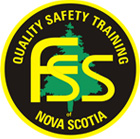Portable Extension / Straight Ladders
Hazards Identified
Slips, falls, electrical shock
Hazard-Specific Personal Protective Equipment
None specific to task
Hazard-Specific Training
First Aid/CPR, Awareness training
Safe Work Practice
- Ensure that ladders are CSA Grade 1 for construction purposes or CSA Grade 1 or 2 for trades purposes. Grade 3 ladders should be immediately discarded. New purchases should be Grade 1.
- Before setting up the portable straight/extension ladder, inspect it for missing or loose parts. Repair or replace as necessary. Ensure that the ladder is free of debris and oil. Clean as required.
When setting up the portable straight/extension ladder:
- Keep the ladder away from electrical sources.
- Do not set the ladder up on mobile equipment or on a moving ferry.
- Secure the base and “walk” the ladder up into place. This may require a second person to stand on the bottom of the ladder while the first person raises the ladder, starting from the top.
- Set the ladder at the proper angle of one horizontal to every four vertical. (1:4).
- Set the top of the ladder to extend one (1) metre above the work station unless the manufacturer specifies the overlap.
- Before using the ladder, make sure locking hooks are secure and that the ladder is secured against movement.
- While ascending or descending the ladder, face the ladder and use three point contact at all times (one hand and two feet, or two hands and one foot). Keep your center of gravity between the side rails. Your beld buckle should never be outside the side rail.
- Do not work from the top three rungs of the ladder.
- Do not paint the ladder. (If required, it may be preserved with a clear coating).
Information Note: Fall Protection and Scaffolding Regulations: 7 (2) (c) ‘where it would not be practical to perform work other than from a ladder and it is not practical for the worker to maintain three points of contact while performing the work, fall protection is required only where and to the extent practical’;
Regulations, Standards and References
Occupational Safety General Regulations, Fall Protection and Scaffolding Regulations Canadian Standard CSA/CAN 3-Z11-M81,Ladders
